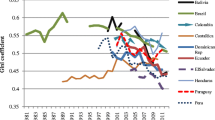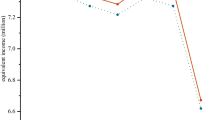Summary
In an input-output framework, income distribution among classes depends on final demand. Traditionally, it has been assumed that the policy-maker selects a distribution vector maximizing his preference function, and it has been attempted to determine this function by an interview. Here, we assume that the policy-maker does not know his preference function but constructs its relevant parts in a communication process with his adviser. This process converges to a (classwise) Pareto-optimal distribution vector and under some further assumptions, any such vector may be attained in principle. Colombian data are used for illustration.
Similar content being viewed by others
References
Frisch, R., ‘Numerical Determination of a Quadratic Preference Function for Use in Macro-economic Programming,’Giornale degli Economisti, XX (1961), pp. 43–83.
Gale, D.,The Theory of Linear Economic Models, New York, 1960.
Georgescu-Roegen, N.,The Entropy Law and the Economic Process, Cambridge, Mass., 1971.
Griffin, K. B., ‘Coffee and the Economic Development of Colombia,’Bulletin of the Oxford University Institute of Economics and Statistics, XXX (1968), pp. 105–127.
Houthakker, H. S., Additive Preferences,Econometrica, XXVIII (1960), pp. 240–257. Reprinted in A. ZELLNER, ed.,Readings in Economic Statistics and Econometrics, Boston, 1968, pp. 155–168.
Kornai, J.,Anti-equilibrium, Amsterdam, 1971.
Kuhn H., andA. W. Tucker,Nonlinear Programming, Second Berkeley Symposium on Mathematical Statistics and Probability, Berkeley, 1952, pp. 481–492. Reprinted inP. Newman, ed.,Readings in Mathematical Economics, I, Baltimore, 1968, pp. 3–14.
Marglin, S. A.,Public Investment Criteria, London, 1967.
Comisión de la reforma tributaria, Bases para una reforma tributaria en Colombia, Biblioteca Banco Popular, Bogotá 1969. (Informe Musgrave’).
Departamento Nacional de Planeación,Análisis estructural de la economia III, IV, Documentos UPG - UCP - 021/22, Septiembre 21 y 28 de 1970 (duplicated).
Oficina Internacional de Trabajo,Hacia el pleno empleo, Un programa para Colombia, preparado por una misión internacional organizada por la Oficina Internacional de Trabajo, Biblioteca Banco Popular, Bogotä 1970.
Author information
Authors and Affiliations
Additional information
I am indebted to Dr. Jacques Melitz for improving my English and to Mr. Roland Fahrion for computational assistance. Nevertheless, I assume sole responsibility for any remaining deficiencies of this paper.
Rights and permissions
About this article
Cite this article
Jaksch, H.J. Income distribution as an objective in development planning. De Economist 122, 1–22 (1974). https://doi.org/10.1007/BF01680189
Issue Date:
DOI: https://doi.org/10.1007/BF01680189




